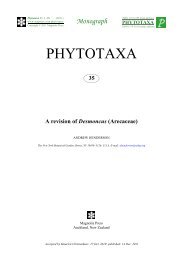Zootaxa, Taxonomy of Serpulidae (Annelida ... - Magnolia Press
Zootaxa, Taxonomy of Serpulidae (Annelida ... - Magnolia Press
Zootaxa, Taxonomy of Serpulidae (Annelida ... - Magnolia Press
Create successful ePaper yourself
Turn your PDF publications into a flip-book with our unique Google optimized e-Paper software.
Remarks. All literature records are based on the same specimen, the holotype. Our seven additional<br />
specimens are all broken (or juvenile), but none <strong>of</strong> the thoraxes still have significant parts <strong>of</strong> the abdomen<br />
attached, at most 1 or 2 chaetigers; the numbers <strong>of</strong> abdominal chaetigers (40, 45, 53, 62) as counted on the<br />
loose abdomens thus probably represent almost complete counts. The specimen collected on 9.II.1956 showed<br />
eggs in its abdomen.<br />
6. Crucigera Benedict, 1887<br />
(Fig. 13)<br />
Type-species: Crucigera websteri Benedict, 1887<br />
Number <strong>of</strong> species: 5<br />
Tube white or yellowish, opaque, circular to semi-circular in cross-section, with or without longitudinal keels<br />
and/or peristomes; tabulae may be present. Granular overlay absent, but outer layer may be shiningly hyaline.<br />
Operculum s<strong>of</strong>t, funnel shaped, formed <strong>of</strong> fused radii. Base <strong>of</strong> funnel with 2–4 finger-like bosses. Peduncle<br />
smooth, cylindrical, without wings, separated from operculum by constriction; inserted proximal from first<br />
and/or second dorsal radiole on one side. Pseudoperculum present. Arrangement <strong>of</strong> radioles in two half to<br />
complete circles, up to 50 radioles per lobe in larger taxa. Inter-radiolar membrane present. Branchial eyes<br />
may be present. Stylodes absent. Mouth palps absent. 7 thoracic chaetigerous segments. Collar trilobed,<br />
tonguelets between ventral and lateral collar lobes absent. Thoracic membranes long, forming apron. Collar<br />
chaetae bayonet-shaped and limbate (Fig. 13A). Thoracic chaetae limbate, Apomatus chaetae absent (Fig.<br />
13B). Thoracic uncini saw-shaped with 5–7 teeth, including simple pointed anterior fang (Fig. 13C).<br />
Triangular depression present. Abdominal chaetae flat trumpet-shaped, with denticulate edge (Fig. 13D).<br />
Abdominal uncini saw-shaped with 4–6 teeth anteriorly (Fig. 13E); rasp-shaped with 2–4 rows, 7–8 teeth in<br />
pr<strong>of</strong>ile posteriorly. Long posterior capillary chaetae present. Achaetous anterior abdominal zone absent.<br />
Posterior glandular pad absent.<br />
Remarks. The genus, with 5 species, was thoroughly revised by ten Hove & Jansen-Jacobs (1984).<br />
However, Kupriyanova et al. (2008) demonstrate that the traditional genera Crucigera and Serpula most<br />
probably are paraphyletic.<br />
1. Crucigera inconstans Straughan, 1967b, Queensland, New South Wales, Western Australia<br />
2. Crucigera irregularis Bush, 1905, Arctic North Pacific, Kamchatka to Washington State<br />
3. Crucigera tricornis Gravier, 1906, widely distributed in the Indo-West Pacific<br />
4. Crucigera websteri Benedict, 1887, Gulf <strong>of</strong> Mexico, Caribbean, Brazil; Pacific Colombia, California<br />
5. Crucigera zygophora (Johnson, 1901), North Japan, Arctic North Pacific, Kamchatka to Washington State.<br />
7. Dasynema Saint-Joseph, 1894<br />
(Fig. 14)<br />
Type-species: Serpula chrysogyrus Grube, 1876<br />
Number <strong>of</strong> species: 1<br />
Tube white, opaque, with some orange, semi-circular in cross-section, with peristomes and (5) irregular<br />
longitudinal keels. Hyaline granular overlay <strong>of</strong> the tube absent. Operculum with fleshy globular ampulla<br />
proximally, calcium carbonate infested chitinous cone distally. Peduncle smooth, without pinnules, broadly<br />
flattened, with unpaired basal wing for 2/3 rds <strong>of</strong> its length and paired small distal wings, separated from<br />
ampulla by constriction; inserted at the base <strong>of</strong> branchial crown below and between 1 st and 2 nd radioles.<br />
Pseudoperculum absent. Radioles arranged in two semi-circles and connected by short inter-radiolar<br />
36 · <strong>Zootaxa</strong> 2036 © 2009 <strong>Magnolia</strong> <strong>Press</strong><br />
TEN HOVE & KUPRIYANOVA
















